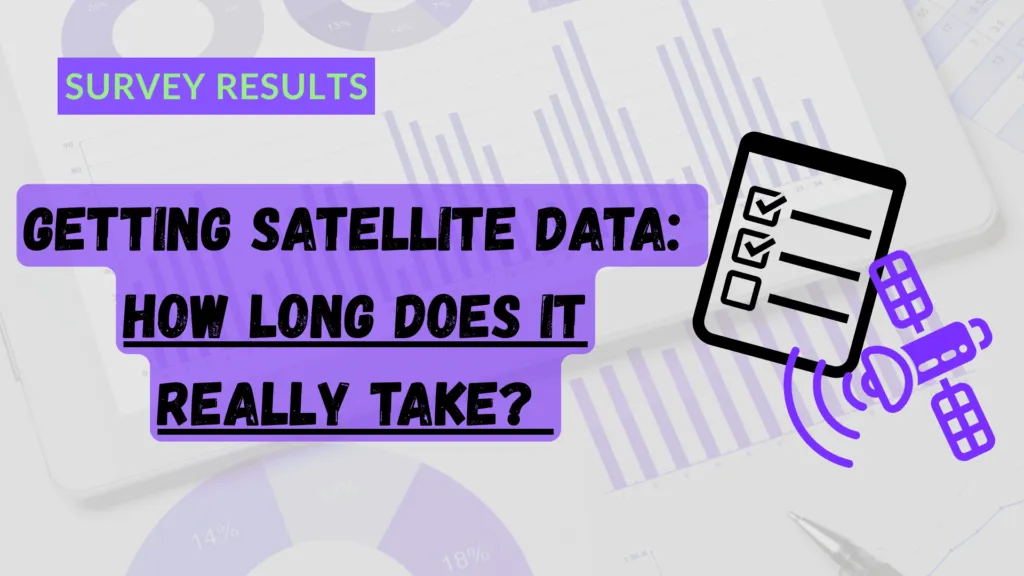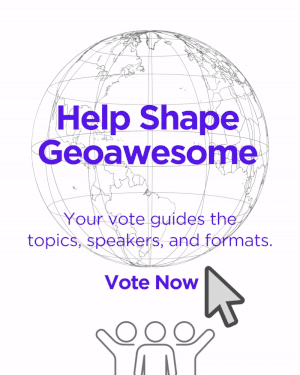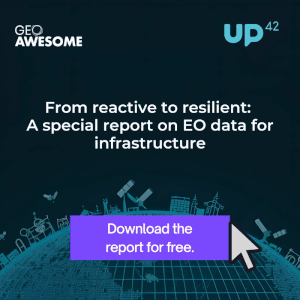
Getting Satellite Data: How Long Does It Really Take? [Survey Results]
Acquiring satellite data can be a complex process, often fraught with significant challenges for EO professionals. While the promise of readily available data is made by many across the industry, the reality of negotiating and acquiring specific satellite images can be far more complicated.
So, how long does it really take to secure the data you need?
We launched a survey aimed at EO users to gain a clearer picture of the satellite data landscape. We gathered insights from 390 people across Geoawesome’s social channels (LinkedIn, X, YouTube Community, and Instagram Reels).
The survey participants represent a highly diverse and global community of geospatial professionals, including data scientists, GIS analysts, engineers, researchers, founders, and government officials. Many of them hold leadership roles or advanced research positions across public institutions, universities, NGOs, and private companies involved in Earth observation, urban planning, environmental monitoring, and spatial data technologies. Their experience spans multiple sectors, including sustainable development, remote sensing, space technology, and infrastructure, reflecting both academic depth and practical expertise.
Our aim? To see firsthand insights into the real-world experiences of those navigating the satellite imagery market right now. From confusing pricing structures and slow sales processes to limitations in data options, we want to uncover the key pain points to help explore potential solutions. Could platforms like UP42 offer a smoother path? Let’s find out.
Q1. On average, how long does it typically take you to obtain the satellite imagery you need from initial request to delivery?
Our first question aimed to get a snapshot of how things are. Respondents picked from the following time periods when asked how long it typically takes them to obtain satellite imagery, from initial request to delivery:
- Less than 24 hours
- 1-7 days
- 1-4 weeks
- Over 1 month
📊 Findings:
A majority of users receive their imagery within 24 hours, but a significant portion still experiences delays. Nearly a quarter wait up to a week, while around 8% receive their data more than a month later. Notably, 17% of respondents reported waiting over a week for their data, pointing to persistent challenges in timely delivery. Receiving Earth observation data within 1–7 days appears to be a stable pattern for a considerable segment of users.
🔍 Observations:
This tells us that the industry is still experiencing growing pains related to data delivery turnaround. The stability of the 1-7 day timeframe suggests consistent processing time for a segment of the market, while increases in longer delays are areas to focus on.
The potential for rapid data delivery exists, but the experience would benefit from improved infrastructure, data processing, or delivery mechanisms within the industry. It is also likely that those who consistently receive their data quickly are already experienced professionals who have established workflows, tools, and partnerships in place. For newcomers or users with less established connections, the process can still be slow or fragmented, highlighting the need for more accessible and standardized delivery solutions across the sector.
These findings are only part of the story. Next, we asked people about the most frustrating part of the satellite imagery acquisition process.
Q2. What is the most frustrating part of the satellite imagery acquisition process for you?
To get an idea of what really grinds the gears of EO data users, we asked them to pick from a selection of common frustrations associated with acquiring satellite data.
- Confusing pricing models
- Slow response time of the provider
- Limited data availability
- Complex licensing terms
📊 Findings:
As you can see in the graph below, the most common complaint, which accounts for 40% of the total, relates to the complexity of pricing models. This is followed by limited data availability, responsible for 29% of the complaints, and complex licensing terms, with 19% of the issues people mentioned. The data shows a growing concern about limited data availability, while frustration with confusing pricing models appears to be declining.
🔍 Observations:
Our research highlights a nuanced landscape where users are increasingly frustrated by data scarcity and licensing complexity.
While the industry might be making steps towards simpler pricing, the challenges of finding the right data and navigating licensing agreements seem to be becoming more pronounced. It appears that accessibility, not just cost, is a major hurdle for those seeking to use satellite data.
The 29% of respondents who responded with limited data availability highlight a growing mismatch between user needs and current satellite coverage. Data scarcity, whether due to restrictive terms or incomplete data sets, can make or break a project.
This tells us that the core issue isn’t just about price anymore: it’s about usability. For the satellite imagery industry, this means the next frontier of innovation is no longer just about reducing costs, but about creating truly flexible, accessible solutions that meet the evolving needs of people across industries. Accessibility is the new competitive advantage.
Q3: How often do you encounter challenges finding the specific type of satellite imagery you need for a project?
Next, we wanted to know if challenges with finding specific data types were a commonplace occurrence. Were they something that people have come to expect, or do they occur now and then? Respondents chose between:
- Rarely or never
- Occasionally
- Frequently
- Almost always
📊 Findings:
According to the survey, 55% of respondents frequently or almost always experience difficulty finding the specific imagery they need. This suggests a persistent challenge within the industry, where over half of users struggle to locate appropriate satellite data for their needs. Meanwhile, only 9% of respondents reported rarely or never experiencing such difficulties, indicating that smooth access to imagery remains the exception rather than the norm. The overall trend points to a need for more intuitive discovery tools and better metadata practices to reduce friction in imagery search and selection.
🔍 Observations:
These findings reaffirm the need for improved access to satellite data. As the demand for satellite imagery grows and applications stretch across industries and become more specialized, users are finding it increasingly challenging to locate the precise data they need.
It’s important to keep in mind that facts such as cloud cover, spatial and temporal resolution limitations, and fragmented data sources likely contribute to these frustrations.
Unified platforms like UP42 offer a glimpse of what’s possible by consolidating diverse data sources and streamlining the search and ordering process. However, these solutions must keep pace with user needs to meet the growing demand for highly specific, high-quality imagery.
Q4. Which factor most influences your choice of satellite imagery provider?
To understand what people are looking for from their provider of choice, we asked what factor influences their decision the most. Changing priorities in the geospatial industry over the years have led us to a place where the amount of data is rarely an issue anymore, with data streaming from space in abundance. After looking at the top factors in the market at the moment, respondents picked from the following:
- Data quality and resolution
- Cost and pricing structure
- Ease of ordering process
- Speed of data delivery
📊 Findings:
In general, data quality and resolution took precedence with 50% of respondents selecting it as the factor that influenced them the most. This was followed by cost and pricing structure at 31%. Notably, the speed of data delivery seemed to be a less significant factor with an overall ranking of 6%.
🔍 Observations:
The geospatial industry is evolving rapidly, with a growing focus on cost-effectiveness and user-friendly solutions. It’s clear from the results of this question that cost is increasingly becoming a dominant factor. Why? This may be due to tighter budgets across all industries. This shift reflects broader trends we’re seeing as prices rise, and economic pressures force organizations to optimize their spending on satellite data.
As applications for satellite imagery expand, users are seeking more flexible and cost-effective solutions. This is evident in this small sample survey already, as the industry heads towards a more customized, accessible data acquisition process.
Why was the speed of data delivery the lowest priority? This suggests either a long-term project focus, with geospatial applications, such as climate change analysis and urban planning, often prioritizing data quality and cost efficiency over immediate delivery. Users now focus on these factors, indicating that data access has improved to the point where urgency is no longer a primary concern.
Q5. How much time do you typically spend researching and comparing satellite imagery options before making a purchase?
This question aimed to understand how users navigate the research and selection process. It has become a crucial step for industry stakeholders. The time spent comparing and evaluating satellite imagery options can tell us a lot about decision-making strategies and market dynamics. When asked how much time they typically spend researching and comparing options before making a purchase, respondents could choose between:
- Less than 1 hour
- 1-5 hours
- 5-10 hours
- Over 10 hours
📊 Findings:
The majority of respondents, 32%, spend less than an hour of their time doing research and comparing options. 26% said they spend 1-5 hours on this, while 26% invest over 10 hours.
26% of respondents are reporting that they spend over 10 hours on this step.
🔍 Observations:
This shift towards shorter research times could be down to the change in the year, bringing a fresh perspective on the time spent researching. As users become more familiar with providers and their offerings, they may spend less time researching for subsequent purchases. These repeat purchases could be an interesting area of research for the future, as companies looking to support users with data acquisition look to create solutions that keep them coming back for more.
The findings above suggest that quick decision-making is becoming increasingly important. Providers and resellers may need to focus their efforts on simplifying offerings and improving the clarity of their value proposition to cater to those looking to spend less time researching, and more time using satellite data.
Data overload could be a reason why the majority of respondents spend less than an hour on this step. The growing volume of available satellite data can be overwhelming, causing them to limit their research time. This also may explain why 1-5 hours and over 10 hours weren’t far behind, as answers. While time constraints exist, these findings suggest that users still want to ensure they’re making informed decisions and comparing options effectively. As the industry matures, streamlining the process even further is required.
In the business world, companies that offer strong customer support and guidance can play a critical role in reducing this burden. By assisting users in navigating data platforms, clarifying product options, and matching datasets to specific needs, support teams can reduce decision-making times and enhance user confidence, particularly for those who are new to the field or overwhelmed by information.
Q6. What improvement would most enhance your satellite imagery acquisition experience?
We then wanted to hear from users themselves. What would improve their overall experience? Rather than guessing or assuming from industry experts and companies alike, asking users themselves through small-scale surveys like this or larger market research helps create solutions that truly make a difference. Respondents selected one of the following:
- More transparent pricing
- Faster turnaround times
- Wider selection of products
- Simplified ordering platforms
📊 Findings:
The survey results showed that transparent pricing had the highest importance for our respondents, with 50% voting for it overall. Simplified ordering platforms was next with 25%, and a wider selection of products remained the lowest in the ranking.
🔍 Observations:
User-friendly solutions are continuously emerging. This explains the consistent demand for simplified ordering platforms, underscoring the ongoing need for accessible and intuitive interfaces.
These findings suggest that the industry should focus on developing more transparent pricing models while continuing to improve user interfaces and the ordering process. In time, those organizations that can offer clear, competitive pricing structures while maintaining high-quality data and user-friendly platforms are likely to gain a significant advantage in the market.
Q7. How often do you need to negotiate custom pricing or terms to get the satellite imagery you require?
Let’s take a closer look at how often users need to negotiate. The frequency of custom pricing negotiations tells us a lot about both user needs and industry practices. Survey respondents could pick from the following options when asked how often they need to negotiate:
- Never
- Rarely (<25% of purchases)
- Sometimes (25-50% of purchases)
- Frequently (>50% of purchases)
📊 Findings:
Strikingly, 64% of respondents rarely or never require custom pricing or terms, while 29% frequently negotiate.
🔍 Observations:
It may be down to enhanced standardization of pricing models or reduced flexibility from providers. The popularity of pay-as-you-go pricing models may also be reducing the need for custom negotiations, as these offer more flexibility without requiring long-term commitments. As users become more experienced with satellite data products, this could result in more straightforward purchasing decisions, without the need for extensive negotiations. Automated platforms created thanks to the rise of user-friendly satellite data ordering solutions and marketplaces are streamlining the purchasing process, further reducing the need for custom negotiations.
These findings align with the growing demand for transparent and predictable pricing observed earlier in this survey, as well as other industry surveys, such as GSOA’s pricing trends 2025 panel in January 2025.
All of this suggests that the satellite imagery market is moving towards more transparent and standardized pricing models. However, the fact that 29% of users in our survey frequently negotiate custom terms indicating there is a significant segment of the market with specialized or complex needs that require tailored solutions. Organizations that are able to serve both types of customers well are those that will stand out in the coming years.
Q8. What is your preferred method for searching and ordering satellite imagery?
Finally, our last question looked to know if users had a preference for how they search and order data. We asked them to select either:
- Direct from the satellite operator
- Through resellers/distributors and marketplaces
- Other
📊 Findings:
A significant majority of respondents, 63%, prefer to order directly from satellite operators. Meanwhile, distributors and marketplaces’ usage is at 28%.
🔍 Observations:
While a majority of respondents answered that they prefer to get their data directly from satellite operators, there may be some differing viewpoints amongst them.
In theory, a preference for ordering directly from operators indicates that users value the reliability and perceived quality of getting data straight from the source.
However, as we’ve seen (and experienced ourselves: https://geoawesome.com/eo-hub/a-short-tale-about-how-i-wanted-to-buy-satellite-imagery-and-how-difficult-it-was/), satellite operators often don’t make it easy to buy directly from them, especially if you’re a medium or smaller-sized business.
Many of our respondents may use direct ordering because it’s compatible with existing workflows, especially for governments, which larger satellite companies prioritise for larger multi-year contracts.
Meanwhile, the emergence of user-friendly platforms like UP42, Arlula, and Planet Tasking has changed the game. The slower adoption of respondents could be due to habit, lack of awareness, or concerns about data quality. However, for customers who need to buy data from multiple providers, platforms here have a clear competitive advantage, especially when they standardise data formats across providers.
The fragmentation of the industry, with various operators, resellers, and marketplaces all competing for users’ attention is another big factor to consider. This complexity might slow down the adoption of new ordering methods.
Whatever the reasons, these findings suggest that while the satellite imagery market is evolving, there’s still room for growth in alternative ordering methods. Users are looking for diverse ordering methods, giving marketplaces and resellers the chance to highlight their unique value propositions that both address concerns and demonstrate clear advantages over direct ordering.
Conclusion and Key Takeaways
Our survey pulled back the curtain on the real challenges people face when trying to get the satellite data they need. While these insights provide a valuable snapshot, longitudinal studies with a larger sample size would validate and expand our current understanding.
That being said, it’s obvious even from this small-scale survey that getting satellite data isn’t always straightforward.
Users are tired of:
- Hunting endlessly for the right image
- Dealing with complicated pricing
- Struggling with clunky ordering systems
What they really want is simple:
- Clear pricing
- Easy-to-use platforms
- Reliable, high-quality data
✔️ Key takeaways:
- Data accessibility remains a significant hurdle, with 61% of respondents frequently struggling to find specific imagery.
- Cost considerations are gaining prominence, now rivaling data quality as a key decision factor.
- Users are spending less time researching options, suggesting a need for more streamlined, transparent offerings.
- There’s a growing demand for pricing transparency, with 54% of respondents citing it as the most desired improvement.
- Direct ordering from operators still dominates, but there’s potential for alternative platforms to gain traction.
While progress has been made, there’s still work to be done. By focusing on these key areas, the industry can move towards a future where high-quality satellite data is actually more accessible, affordable, and easier to use for all.
The companies that figure this out won’t just survive, they’ll become the go-to solution for users who need accurate, timely data without the runaround.
The satellite data world is changing. And the game-changers will be those who listen to what users actually want, not what they think users want.










